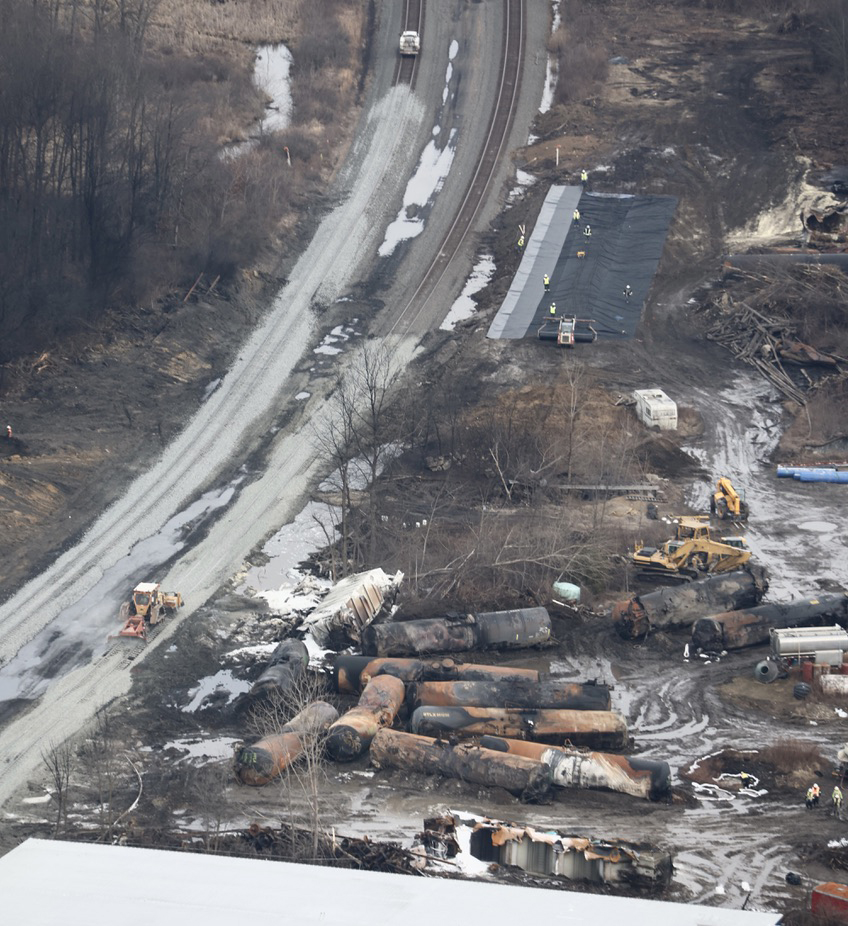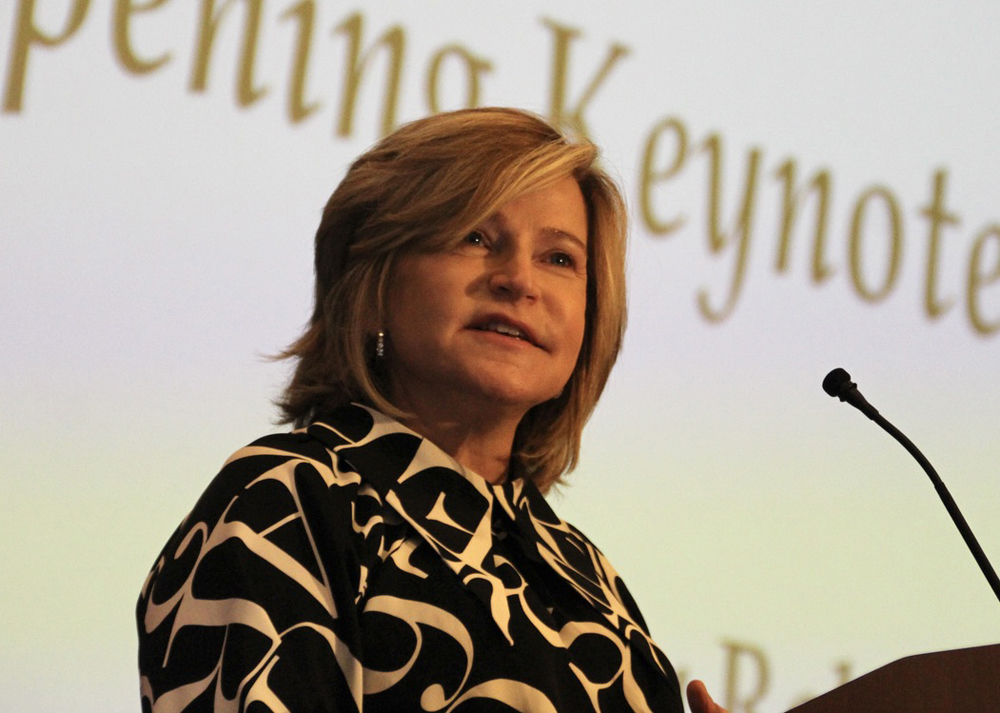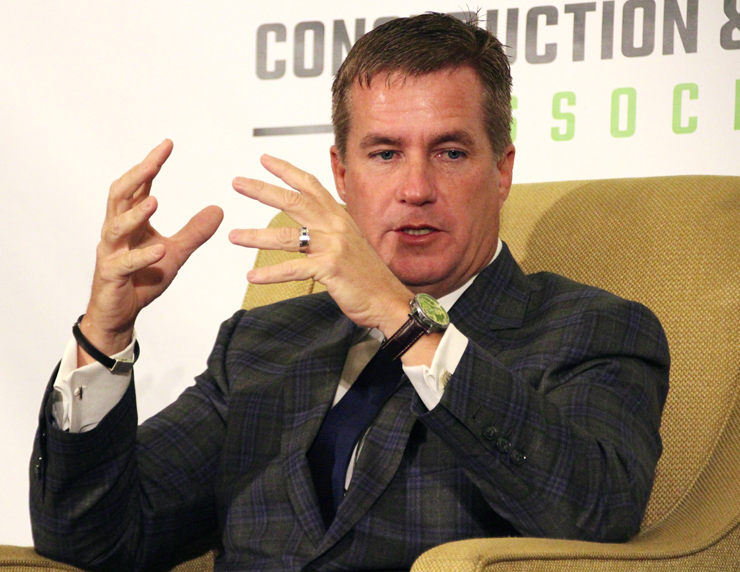
Regulators should not impose new safety regulations until the National Transportation Safety Board determines what caused the fiery derailment of a Norfolk Southern train that was carrying hazardous materials through East Palestine, Ohio, rail industry leaders said today.
Their remarks came just hours after Transportation Secretary Pete Buttigieg said the Department of Transportation would adopt several new regulations covering hazardous materials shipments as part of a broader push to improve rail safety [see “Department of Transportation to urge railroads and Congress to improve rail safety,” Trains News Wire, Feb. 20, 2023].
Canadian National CEO Tracy Robinson told an investor conference that all of the railroads want to be as safe as possible. But she said that regulators shouldn’t impose solutions that don’t relate to the underlying problem.

“You run the risk of not only not fixing what the core problem is, but you could have these inadvertent, unintended consequences of applying the wrong solution to a not well-understood problem,” she says.
“There is no shortage of desire in this industry to be safer and safer,” she says.
Canadian Pacific CEO Keith Creel told the same investor conference that it’s important for the industry to understand and then address the cause of the East Palestine derailment. Once the railroads take corrective action, there should be no need for additional regulations, Creel says.
“Zero accidents is the objective,” Creel says. “But getting there is a journey.”
Should railroads work with regulators now on new safety regulations?
“As soon as they understand what the cause is, they will be as aggressive and eager as we are to make it better, to make it safer,” Creel responded.
“This is not a case of people don’t care,” he adds.
Creel pushed back against criticism of the Precision Scheduled Railroading operating model in the wake of the East Palestine accident.
Unions have claimed that widespread job reductions at the U.S. Class I railroads have reduced the margin of safety over the past six years despite the industry’s increasing profitability. Critics have sought to blame the East Palestine wreck on the operation of longer trains and less rigorous train inspections.
CP has spent 50% more on its infrastructure in the decade since adopting PSR than in the previous decade, Creel says. “Only because of PSR could we do that,” he says.

CP just marked its 17th straight year with the industry’s lowest train accident rate, Creel noted, despite being a PSR railroad that runs long trains.
Ian Jefferies, CEO of the Association of American Railroads, said the industry is committed to taking steps that directly address the cause of the East Palestine derailment so that similar accidents could be prevented elsewhere.
“The NTSB’s independent investigators continue their work to identify the accident’s root cause and contributing factors,” Jefferies says. “That investigation must continue unimpeded by politics and speculation so NTSB’s findings can guide what additional measures may have prevented this accident.”
Buttigieg, in an interview today with ABC News, said there was no need to wait for the investigation to conclude before addressing broader safety concerns in the rail industry. He also was critical of railroads’ historical resistance to new safety regulations.
In a series of tweets on Thursday, NTSB Chair Jennifer Homendy urged people to stop spreading misinformation about the wreck, its potential cause, and ways railroads might have prevented the disaster that forced the evacuation of the town.
“Urgent safety recommendations may be issued at any time; meaning, we don’t wait until the end of our investigation if immediate safety action is warranted,” she wrote.
The use of electronically controlled pneumatic, or ECP, brakes would not have prevented the derailment, she noted. And she said that the ECP brake rule proposed in 2015 would not have applied to the NS train 32N that derailed on Feb. 3 because it did not meet the standards for a high-hazard flammable train.
“I urge you: let the NTSB lead the safety analysis. Anything else is harmful — and adding pain to a community that’s been through enough,” Homendy wrote.
The Environmental Protection Agency today ordered NS to pay for a full cleanup at the derailment site where toxic chemicals were spilled. NS CEO Alan Shaw has said the railroad will pick up the tab and “make things right” for the community.
NS on Monday announced that an employee who lives in East Palestine has accepted a one-year assignment as a dedicated community liaison. He will report directly to Shaw’s chief of staff, work directly with top leadership, and have a $1 million budget to fund community needs and improvements.














When one bearing is running hotter than the others in a train its time to stop the train and walk the train. Had this happened the defective car could be located and set off.
We need a better analytical approach to this situation of defective bearings. Your bottom line should not push safety out of the situation.
The industry constantly takes chances and rolls the dice.
Pneumatic brakes can stop an iron ore train, very long and very heavy in about 600 feet. For over 100 years we have had the same braking system which was fine for 60 car trains.
Time to come into the 21st century. Theres always problems with new tech in any industry. We need to have investments by the railroads, i.e. use some of the profits to towards improving braking.
NTSB Jennifer Homendy says NS train 32N “did not meet the standards for a high-hazard flammable train”. Perhaps it is time to change the standards.
When you want an experienced safety expert always ask the nearest TV reporter.
AMEN! I will also add nearby politician.
– The air brake
– The modern coupler
– Derailer on sidings
– Reflective switch setting indicators
– Electric signaling (from manual semaphores)
I don’t think the Feds made them do these. The first two were motivated by profit pure and simple. Too many workers were getting killed or maimed in rail car accidents.
Feds drove these
– DOT tank car standards
– PTC
– EOT devices
– Ditch lighting
– Track evaluation process for slow orders
Actually, the modern coupler and air brakes were the result of federal legislation.
I seriously think that (most) railroads don’t do anything safety related unless the government tells them to, mainly because there’s a video of the news covering CSX 8888, and in one of them, the reporter stated,”The technology exists, but so far the government has not required it, and most freight railroads hadn’t spent the millions needed to have it installed”. Guess what happened? 2008 occurred, and the Chatsworth train crash occurred and then the government started mandating systems like PTC, but some railroads hadn’t completed the entire installation by 2015 which was when Amtrak 188 occurred. (Though, as much as people say that PTC could have prevented it, I’m going to say this right here right now. Having another person in the cab of Amtrak 601, which was the locomotive leading train 188 could have prevented the crash.) So honestly, the way that a lot of the industry is saying that safety is their priority, I think they should ad,”because the federal government mandates so”. I said federal government because state governments can enact their own laws (*cough* Iowa & Arizona), but they don’t really apply. If I’m wrong about any of this, and if I’m stupid, please tell me. I need to know.